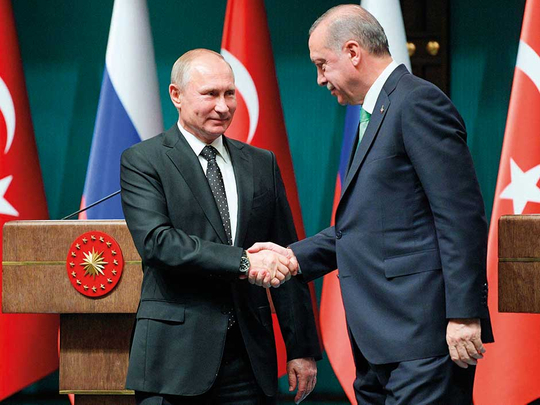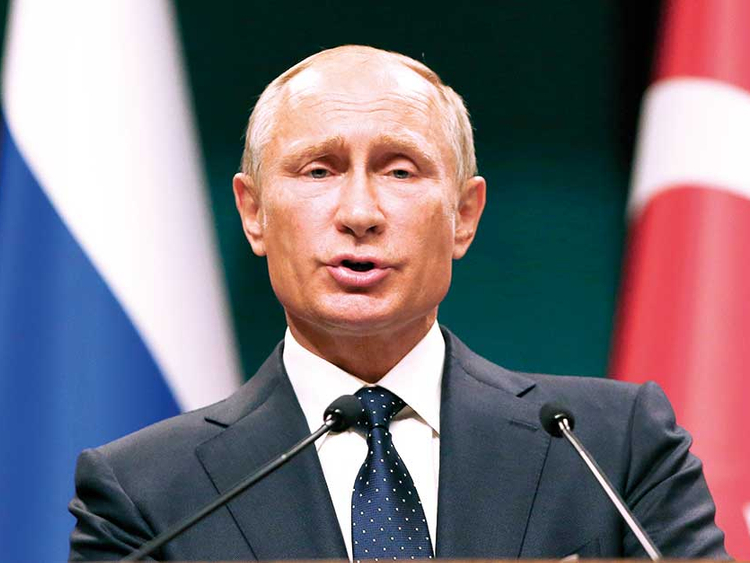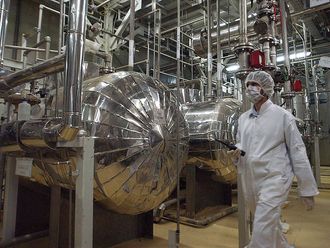
On December 11, 2017, Russian President Vladimir Putin landed at the Russian military base in Hmeimeem, southeast of the city of Latakia on the Syrian coast, where he met with Russian troops serving there since September 2015.
Triumphantly, Putin announced declared “mission accomplished”, saying that thanks to his country’s military intervention in the Syrian conflict, Daesh had been annihilated.
Russian troops cheered their commander-in-chief, while analysts immediately started dissecting the symbolism-heavy visit, trying yet again to understand the man who, in the region and on the global stage for the past few years, has filled gaps that the Americans have left behind — or stepped in in situations Washington can no longer handle on its own.
What now for Putin? His ally in Damascus is seemingly out of harm’s way, and the war on Daesh is coming to a rapid end, expected to close by February. David Lesch, who has written extensively on the Middle East, believes that once that happens, Putin will try to “drastically reduce Russia’s footprint in Syria while maintaining its military bases and some economic influence”.
To do that, however, he needs to talk politics and show the world that he can pressure the Syrians to engage in a real and substantive political process. The Texas-based professor at Trinity University added: “Putin desperately wants some sort of political settlement to crown the military victory in Syria, in order to prevent any semblance of getting stuck in a long-term quagmire, which would be in stark contrast to what happened to the Americans in Iraq.”
More than any other Russian leader in the past half century, Putin is obsessed with theatrics and symbolism.
For example, he insisted on visiting Hmeimeem, rather than Damascus, to project Russia’s expanding military influence throughout the Middle East. From the base, Putin headed to Egypt, a country that had expelled Russian advisers and military personnel more than 40 years ago, during the Cold War.
For four solid decades, Cairo cuddled up to the United States, yet Putin is now is reaching out to President Abdul Fattah Al Sissi, given Egypt’s historic influence in Arab affairs. He also visited Turkey, a Nato member state, whose president, Recep Tayyip Erdogan, has been inching closer to the Kremlin, feeling backstabbed and betrayed over the Kurdish issue, first by former US president Barack Obama and then by his successor Donald Trump. The one-day visit projected the scope, outreach, and unstoppable ambition of Putin.
By announcing that he was withdrawing some Russian troops from Syria, Putin was making a point inside Russia: that young men in uniform will not remain indefinitely in a country that is not theirs, and that he would be bringing the boys home, ahead of the Russian New Year.
By no means was Putin disengaging from Syria, as some in the Syrian opposition claimed. Far from it, he was only withdrawing extra troops who had been sent to Hmeimeem over the past year, who helped wrap up the battles of Aleppo in December 2016. The troop reduction does not apply to senior officers based in Syria or the Russian military police now running the ‘de-escalation’ zones Putin carved out since last May, east of Damascus, north of Homs, and in the Syrian south.
More than 600 are permanently based in Al Ghouta, the countryside of Damascus, and an equal number are stationed in Aleppo, overseeing convoys of humanitarian aid, while checking for unsolicited arms. And another 1,000 are stationed in the stretch of land from the Syrian-Jordanian border to the countryside of Suwaida in the Druze mountains.
Putin recently submitted a proposal to the lower house of Russia’s parliament, transforming the Tartous navy refueling facility into a full-fledged base capable of harbouring nuclear-powered ships. The agreement would last for 49 years, until 2066. It would grant the Russians access to the territorial waters of Syria and to all ports.
A revamped Tartous port would now be capable of taking 11 Russian ships at once. A new base is already being constructed in Khirbet Ras Al Waer, not far from the Syrian-Jordanian border. Hmeimeem would stay in tact, leased to the Russians for 49 years, extendable for an additional 25. Meaning, its there to stay until 2091. By the time, Putin would be long dead, but his influence in Syria and beyond will still be strongly felt.
Putin is putting his final touches on a ‘national dialogue’ conference for Syria, tentatively scheduled for mid-January 2018. Over 1,000 delegates will be invited to attend to sign off a political endgame to the Syrian conflict — on Putin’s terms and conditions.
During his meeting with Trump in Vietnam in early November, Putin was given the go-ahead on Sochi, provided that Iran is either excluded from the talks or invited as an observer only.
Putin promised to make sure the Iranians would get no decision-making power at Sochi similar to the one given to them at the Astana process that started last January. What Sochi produces is not that important for Trump, who has seemingly also surrendered to Putin’s vision for the Syrian endgame, even if it means Bashar Al Assad’s survival. For Trump, the priorities in Syria are eradicating Daesh (which has been achieved), empowering the Kurds (also accomplished), and clipping the wings of Iran and Hezbollah, in anticipation of getting them to leave the Syrian battlefield.
Putin’s Syria strategy will include a new charter in 2018 that ushers in a quasi-federal system, similar to the Russian Federation, topped with parliamentary elections in 2019. Presidential ones will happen on-schedule in 2021 and Putin insists they will be free and democratic, monitored even by the UN. His top diplomats insist that Al Assad is entitled to run for a fourth term as president, lasting until 2027.
By announcing his withdrawal from Syria, Putin hopes to get other stakeholders to withdraw as well, namely the Turks from Idlib in the Syrian northwest, Iran from the Syrian north, and Hezbollah from the Syrian south.
Wael Sawah, editor-in-chief of The Syria Observer, noted: “Russia cannot afford to lose Syria. Putin has invested a lot. Like a poker player, he played all in, after he was hoodwinked in Libya. Both luck and good strategy made him win.”
Speaking to Gulf News, he added: “I don’t believe he is now ready to reconcile. It is time he harvests the revenues and profits of what he capitalised. Reconstruction is what he is waiting for.”












